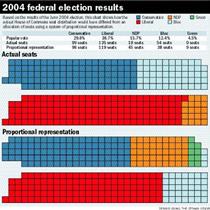Proportional representation
Interesting article in today's Ottawa Citizen about the merits of proportional representation.
The problem with the current system is that leads to a lot of wasted votes and basically absolute power if the winner can get enough seats rather than votes to put them over the top. For instance, Jean Chretien won a majority government in 1997 with just over 1/3 of the votes (38%). This is an affront to basic fairness. See the graphic below for how the 2004 election would have impacted the House of Commons if a system of PR was employed:

As the graph shows, PR favours national parties over regional ones, and it also allows for smaller parties like the Greens to get a foothold. This is both desirable, fair, and healthy for new ideas within the democratic process The article points out a few of the outcomes that have resulted from the current system:
- In the 2004 election, 300,000 people voted for the Conservatives in Quebec and were unable to elect one MP. In the same election, the 178,000 voters who supported the Conservatives in Saskatchewan sent 13 MPs to Ottawa.
In that same election, 580,000 Green party voters failed to elect a single MP while 500,000 Liberal supporters in Atlantic Canada sent 22 candidates to Parliament.
- Canada's first-past-the-post electoral system frequently results in distorted election outcomes. One of the largest distortions occurred in 1984 when Brian Mulroney's Conservatives won 75 per cent of the seats in Parliament with 50 per cent of the popular vote. Jean Chretien's three majority victories also produced significant distortions for the Liberals: 19 per cent in 1993, 13 per cent in 1997 and 17 per cent in 2000.
- Since the end of the First World War, Canada has elected 15 majority governments. But only four of those elections -- in 1940, 1949, 1958 and 1984 -- produced "true" majorities in which more than half the voters supported the winning party.
- In the 2000 election, a record 22 candidates were elected to Parliament despite winning less than 40 per cent of the votes in their ridings.
- In its first election in 1993, the Bloc Quebecois formed the official opposition in Parliament even though it finished fourth in the popular vote behind the Liberal, Reform and Conservative parties.
I think it would be a little drastic to change the first-past-the-post system to one of proportional representation right away. Instead, I think the first-past-the-post system should be retained for the House of Commons, which would guarantee regional representation at the federal level, and a proportional representation system should be introduced in an elected Senate. Each body should also have fixed election dates, with elections happening every other two years in each body, respectively. By the time legislation is passed through the Senate, it would be modified to better reflect the consensus of the country overall rather than just the governing party. There are many examples of contentious laws that have been put in place by the Liberals from 1993-2004 because they were able to use their House majority in tandem with a stacked Senate. The rest of the country who were not supportive of each initiative were left to live with whatever outcome that party deemed best for the country despite the fact that they were voted in with less than 50% of the ballots cast. A proportionally representative Senate could also provide an advisory function for things like appointments. The way it is now, the governing party can stack the Supreme Court with ideological fellow travellers with no check or balances on who they put forward. Is this fair?
I think that PR has its benefits but completely upend the House without looking at a way to include the Senate would be a missed opportunity to undertake real reform that could result in fairer representation, better legislation, and hopefully a more engaged public.

0 Comments:
Post a Comment
<< Home